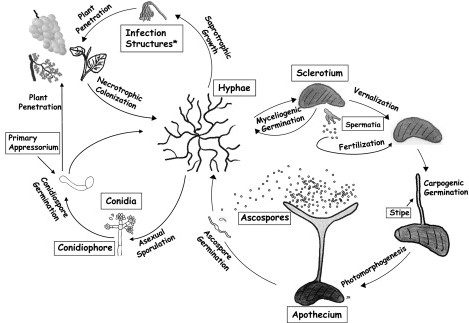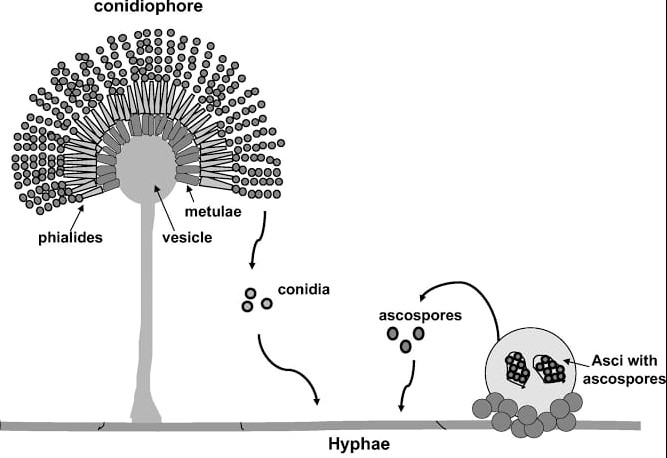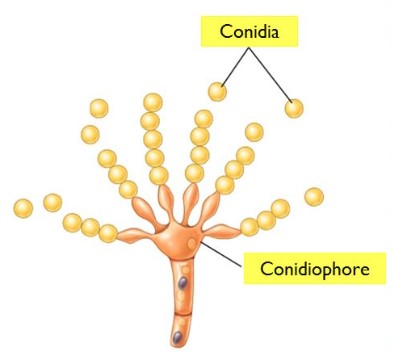Fungi represent a fascinating kingdom of organisms that play crucial roles in our ecosystem, from decomposing organic matter to participating in symbiotic relationships with plants. The reproductive mechanisms of fungi are complex and varied, involving structures that are not only intriguing but also vital for their propagation and survival. Among these, conidiophores and sporangiophores stand out due to their distinctive roles in the fungal reproductive system.
Conidiophores and sporangiophores are specialized fungal structures responsible for asexual reproduction, but they operate in markedly different ways. Conidiophores disperse spores known as conidia, which are not enclosed within a sac. Sporangiophores, on the other hand, bear spores called sporangiospores within a protective sac known as a sporangium. These structures ensure the efficient reproduction and spread of fungi under various environmental conditions.
Understanding these differences is crucial for scientists, agriculturists, and anyone interested in the biological sciences, as it sheds light on fungal diversity, ecology, and the potential applications of fungi in biotechnology and medicine. The specificity of each structure to its role in the lifecycle of fungi underscores the evolutionary adaptability of these organisms to their surroundings.

Fungal Basics
Definition of Fungi
Fungi are a kingdom of organisms distinct from plants, animals, and bacteria. They include a diverse range of organisms such as yeasts, molds, and mushrooms. Fungi are essential to many ecosystems as decomposers, breaking down dead organic material and recycling nutrients back into the soil. Unlike plants, fungi do not photosynthesize; instead, they absorb nutrients from their environment.
Overview of Fungal Reproduction
Fungi reproduce through both sexual and asexual methods. Asexual reproduction is common and involves the production of spores that are directly released into the environment. These spores can germinate and grow into new fungal organisms. Sexual reproduction, on the other hand, involves the fusion of two genetically distinct cells, leading to genetic diversity. This process can occur through various complex life cycles, depending on the fungal species.
Key Terms in Fungal Biology
- Mycelium: The vegetative part of a fungus, consisting of a network of fine white filaments (hyphae).
- Hyphae: The thread-like structures that make up the mycelium of a fungus.
- Spore: A reproductive cell capable of developing into a new individual without fusion with another cell.
- Conidia: Asexually produced spores often found in conidiophores.
- Sporangiospores: Spores produced in a sporangium, typical of some fungi.
Conidiophores Explained
Definition and Characteristics
Conidiophores are specialized fungal structures that function as spore-producing systems. They are a type of hyphae that stand upright and produce spores at their tips or along their sides. These structures are key to asexual reproduction in many fungi, allowing for the rapid spread and colonization of new areas.
Role in Asexual Reproduction
The primary role of conidiophores is to disperse conidia, the asexual spores of fungi. This process allows fungi to reproduce quickly and efficiently, often in response to favorable environmental conditions. Conidia can be spread by wind, water, or animals, making them an effective means of propagation.
Types and Examples
- Simple Conidiophores: These are unbranched structures that produce a single spore at their tip.
- Branched Conidiophores: These structures have multiple branches, each capable of producing spores.
Examples of fungi with conidiophores include Aspergillus, a genus that produces spores in a characteristic bottle-shaped structure, and Penicillium, known for its brush-like conidiophores.
Sporangiophores Detailed
Definition and Features
Sporangiophores are another type of fungal structure dedicated to spore production, but unlike conidiophores, they produce spores inside an enclosure called a sporangium. This protective sac opens to release sporangiospores when conditions are right for germination. Sporangiophores are typically taller and sturdier than conidiophores, as they need to support the weight of the sporangium.
Role in Fungal Lifecycle
The sporangiophores play a crucial role in the lifecycle of certain fungi, facilitating the spread and germination of spores. By producing spores in a protected environment, sporangiophores ensure a higher viability rate for the spores, increasing the chances of successful colonization.
Varieties and Instances
Sporangiophores vary widely in terms of size, shape, and number of spores produced. Some fungi produce large, visible sporangiophores, while in others, they may be microscopic.
An example of a fungus with sporangiophores is Rhizopus, a common bread mold that produces black, pin-like structures visible to the naked eye. Another example is Mucor, which has sporangiophores that end in a globular sporangium filled with spores.

Comparative Analysis
Structure Comparison
Physical Distinctions
Conidiophores and sporangiophores, though both pivotal in fungal reproduction, exhibit distinct physical characteristics. Conidiophores often emerge as slender, stalk-like structures that directly expose their spores to the environment. This exposure facilitates immediate spore dispersal upon maturity. In contrast, sporangiophores stand out with their typically robust form, culminating in a sporangium, a sac that houses spores until they are ready for release. The presence of a sporangium is a defining feature that not only distinguishes sporangiophores from conidiophores but also impacts spore dispersal mechanisms.
Location and Development in Fungi
The development site of these structures is key to their function. Conidiophores are commonly found on the surface of the fungal body, maximizing their exposure to air currents for spore dispersal. Sporangiophores, meanwhile, often develop in more protected areas, as the sporangium needs to accumulate a sufficient number of spores before release. The growth environment—whether it be on the surface of a leaf, within decomposing matter, or in the soil—plays a crucial role in determining the structural adaptation of these reproductive units.
Functional Differences
Reproductive Roles
The primary function of both conidiophores and sporangiophores is asexual reproduction, but the mechanism of spore release and dispersal diverges significantly. Conidiophores allow for rapid reproduction under favorable conditions, as their conidia can be directly carried away by the wind. Sporangiophores, with their protective sporangium, can delay spore release until conditions are optimal, which might include factors like humidity and temperature.
Impact on Fungal Dispersal
The method of spore release significantly affects fungal dispersal strategies. Conidiophores, by releasing spores continuously, can exploit transient optimal conditions, leading to widespread colonization. Sporangiophores, on the other hand, release spores en masse, creating the potential for a more concentrated initial colonization effort in a new area. This distinction underlies the ecological niches that different fungi can occupy and exploit.
Ecological Significance
Conidiophores and Environmental Adaptation
Conidiophores represent a versatile adaptation to diverse environmental conditions. By producing spores that are ready for immediate dispersal, fungi with conidiophores can quickly take advantage of fleeting resource availability or sudden changes in the environment. This adaptability is crucial in dynamic ecosystems, where conditions change rapidly and resources are sporadically available.
Sporangiophores in Ecosystem Dynamics
Sporangiophores, with their delayed release mechanism, play a different but equally important role in ecosystem dynamics. The ability to store spores until conditions are favorable for germination ensures that sporangiospores are released into the environment when they have the highest chance of survival and growth. This strategy is particularly effective in stable but competitive environments, where timing and location can significantly influence the success of fungal colonization.
Practical Implications
Importance in Agriculture
Both conidiophores and sporangiophores have significant implications for agriculture. Fungi with conidiophores can rapidly colonize crops, leading to diseases such as powdery mildew or fruit rot. Understanding these mechanisms is crucial for developing effective fungicides and management strategies. Similarly, fungi with sporangiophores can cause diseases like damping-off in seedlings, where understanding their reproductive cycles can aid in timing preventive measures.
Relevance in Medicine
In the medical field, fungi play dual roles as both pathogens and sources of antibiotics. Some fungi that produce conidiophores are responsible for human diseases, such as aspergillosis. However, these same fungi can be cultured to produce antibiotics, such as penicillin from Penicillium. The study of sporangiophores is equally important, as it helps in understanding the life cycle of fungi that might affect immunocompromised individuals or contribute to antibiotic production.
Applications in Biotechnology
The detailed understanding of fungal reproductive structures extends into biotechnology, where fungi are harnessed for the production of pharmaceuticals, enzymes, and other biochemicals. Genetic engineering of fungi requires knowledge of their life cycles, including how conidiophores and sporangiophores develop and function. This knowledge facilitates the optimization of fungal cultures for mass production of valuable compounds.

FAQs
What are conidiophores?
Conidiophores are aerial, specialized hyphae in fungi that bear conidia, the asexually produced spores. Unlike sporangiophores, conidia are not enclosed in a sac but are exposed, which facilitates direct dispersion into the environment. This method of reproduction is common in various fungi, including those in the Aspergillus and Penicillium genera, and plays a key role in their lifecycle and propagation.
How do sporangiophores differ from conidiophores?
Sporangiophores are fungal structures that produce and bear sporangiospores within a sac called a sporangium. The key difference from conidiophores is the presence of this protective sac, which eventually bursts to release the spores. This structure is typical in certain fungi, such as Rhizopus, and is crucial for their reproductive strategy, ensuring spore viability and distribution.
Why are conidiophores and sporangiophores important?
Conidiophores and sporangiophores are integral to the asexual reproductive cycles of fungi, playing vital roles in spore dispersal and colonization. Their study helps in understanding fungal ecology, disease spread in crops, and the development of antifungal strategies. Additionally, these structures are pivotal in the industrial production of antibiotics, enzymes, and other valuable biochemicals through fermentation processes.
Conclusion
The intricate world of fungi is marked by a diversity of reproductive strategies, with conidiophores and sporangiophores serving as keystones in their asexual reproduction. Their differences highlight the adaptability and evolutionary success of fungi across various habitats. By shedding light on these unique structures, we gain insights into the broader implications for ecology, agriculture, and biotechnology.
In conclusion, understanding the distinct roles and mechanisms of conidiophores and sporangiophores not only enriches our knowledge of fungal biology but also opens up pathways for scientific exploration and practical applications. These structures exemplify the complexity of life and the endless possibilities for leveraging biological systems to address environmental and societal challenges.

